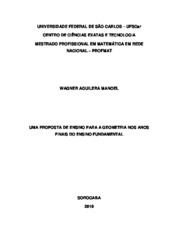| dc.contributor.author | Manoel, Wagner Aguilera | |
| dc.date.accessioned | 2019-04-01T13:45:05Z | |
| dc.date.available | 2019-04-01T13:45:05Z | |
| dc.date.issued | 2019-02-14 | |
| dc.identifier.citation | MANOEL, Wagner Aguilera. Uma proposta de ensino para a Geometria nos anos finais do Ensino Fundamental. 2019. Dissertação (Mestrado em Matemática em Rede Nacional) – Universidade Federal de São Carlos, São Carlos, 2019. Disponível em: https://repositorio.ufscar.br/handle/ufscar/11168. | * |
| dc.identifier.uri | https://repositorio.ufscar.br/handle/ufscar/11168 | |
| dc.description.abstract | The importance of teaching Geometry is a present theme in several researches in Mathematic Education (LORENZATO 1995, FONSECA et. al 2002; BRESSAN; BOGISIC; CREGO, 2010). These authors consider fundamental the presence of geometry in the school environment, be it for the importance of this subject in the culture and in the history of humanity, or be it through cognitives abilities that it develops, or, even through the fact that it is present in the student's day-to-day routine.
Manoel (2014) has classified the contributions of teaching geometry in eleven axes of analyses (Curriculum, History, Other Areas of Knowledge, Nature, Quotidian, Affectivity, Problems Solving, Cognitive Abilities, Critical Thinking, Aesthetics Appreciation and Creativity) and has affirmed that these axes could be used as a method of Teaching Geometry. In the face of this problematic, the question that has emerged and has guided this research was: which are the contributions that the eleven axes can make it possible as methodology of teaching geometry for the second segment of middle school? The purpose of this research was to analyze the methodology of the 11 axes and to identify their contributions to the teaching of Mathematics in the situations of proposed learning. The methodology of research chosen was the qualitative of the naturalistic type, according to Fiorentini e Lorenzato (2006). The analyze, done with the help of five teachers from two schools from the city a Sorocaba-SP, it has used the register of the activities of these teachers. Through our analyze, it was possible to conclude that the eleven axes as a method of teaching Geometry help teachers in the preparation of their mathematic classes, choosing or creating activities or selecting the didactic material that present a greater amount of axes, contributing therefore for a preparation of more diversified, formative, critical, stimulating and creative classes, providing a better teaching of mathematic and an aid to other subjects such as Sciences, Physics and Arts. | eng |
| dc.description.sponsorship | Coordenação de Aperfeiçoamento de Pessoal de Nível Superior (CAPES) | por |
| dc.language.iso | por | por |
| dc.publisher | Universidade Federal de São Carlos | por |
| dc.rights.uri | Acesso aberto | por |
| dc.subject | Geometria | por |
| dc.subject | Ensino de geometria | por |
| dc.subject | Metodologia de ensino | por |
| dc.subject | Geometry | eng |
| dc.subject | Teaching geometry | eng |
| dc.subject | Methodology of teaching | eng |
| dc.title | Uma proposta de ensino para a Geometria nos anos finais do Ensino Fundamental | por |
| dc.title.alternative | A Geometry Teaching proposal for Middle School. | eng |
| dc.type | Dissertação | por |
| dc.contributor.advisor1 | Noel Filho, Antonio | |
| dc.contributor.advisor1Lattes | http://lattes.cnpq.br/5234064498436000 | por |
| dc.description.resumo | A importância de ensinar Geometria é tema presente em diversas pesquisas em Educação Matemática (LORENZATO 1995, FONSECA et. al 2002; BRESSAN; BOGISIC; CREGO, 2010). Esses autores consideram fundamental a presença da Geometria no ambiente escolar, seja pela importância dessa disciplina na cultura e na história da humanidade, seja pelas habilidades cognitivas que ela desenvolve, ou mesmo pelo fato de ela estar presente no cotidiano do aluno. Manoel (2014) classificou as contribuições do ensino da Geometria em 11 eixos de análise (currículo, história, outras áreas do conhecimento, natureza, cotidiano, afetividade, resolução de problemas, habilidade cognitivas, pensamento crítico, apreciação estética e criatividade) e afirmou que esses eixos poderiam ser utilizados como método de ensino de Geometria. Diante dessa problemática, a questão que emergiu e que norteou esta pesquisa foi: quais as contribuições que os 11 eixos podem possibilitar como metodologia de ensino de Geometria para o segundo segmento do Ensino Fundamental? O objetivo desta investigação foi analisar a metodologia dos 11 eixos e identificar suas contribuições para o ensino de Matemática nas situações de aprendizagens propostas. A metodologia de pesquisa escolhida foi a qualitativa do tipo naturalista, segundo Fiorentini e Lorenzato (2006). A análise, feita com o auxílio de cinco professores de duas escolas da cidade de Sorocaba-SP, utilizou o registro das atividades destes docentes. Através de nossa análise, foi possível concluir que os 11 eixos como método de ensino de Geometria auxiliam os professores na elaboração das aulas de matemática, seja na escolha e na criação de atividades ou na seleção de materiais didáticos que apresentem o maior número de eixos, contribuindo assim para a preparação de aulas mais diversificadas, formativas, críticas, estimulantes e criativas, propiciando um melhor ensino de Matemática e um auxílio a outras disciplinas como Ciências, Física e Artes. | por |
| dc.publisher.initials | UFSCar | por |
| dc.publisher.program | Programa de Mestrado Profissional em Matemática em Rede Nacional - PROFMAT | por |
| dc.subject.cnpq | CIENCIAS HUMANAS::EDUCACAO::ENSINO-APRENDIZAGEM | por |
| dc.subject.cnpq | CIENCIAS HUMANAS::EDUCACAO::ENSINO-APRENDIZAGEM::METODOS E TECNICAS DE ENSINO | por |
| dc.description.sponsorshipId | CAPES: Código de Financiamento 001 | por |
| dc.ufscar.embargo | Online | por |
| dc.publisher.address | Câmpus São Carlos | por |
| dc.contributor.authorlattes | http://lattes.cnpq.br/7582791104350693 | por |
